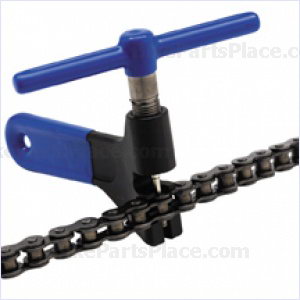
- Chain tools are often specific to the type of chain.
- Pro models have longer handles, which means more leverage.
- A tool with a replaceable pin may be more versatile in the long run.
A bike chain is a bike chain, right? From bike to bike, what looks like the same collection of metal links and pins is actually a precise system designed to work with specific drivetrains.
Like the tools used on the rest of the bike’s moving parts, chains require special chain tools. Such tools are equally precise devices designed to do only one thing – remove and install bike chains.
To do that, one of the pins that connects the links must be driven out, thereby freeing the link. The process is called “breaking” the chain.
Every chain tool is composed of the same essential pieces. There’s a screw-driven pin that can be tightened to drive a pin into or out of a chain. There’s a cradle to hold the chain in place while the crank is being turned. Finally, there’s a handle to turn the pin.
Seems simple, like a bike chain, right?
In reality, the whole system is simple. But there are big differences between the many, many chain tools available. Some chain manufacturers, like Shimano and Campagnolo, make their own chain tools, each specific to their different chain designs.
Much as a 10-speed drivetrain needs special components, the chain itself has pins specific to that drivetrain. Campagnolo’s new 11-speed drivetrain has pins so small it requires those installing it to use a tool specifically created for that chain. Not even Campagnolo’s 10-speed tool will work.
When you’re looking to buy a new chain tool, it’s best to know what kind of chains you have. Be sure to buy a tool that will work with them.
From there, you’ll need to check out the design aspects of each of the chain tools available to you. The cradle that holds the chain is certainly important, but the handle and pin driver are even more important.
The handles should be long enough to get a firm grip with one hand, while allowing a lot of leverage on the crank. For the most part, it takes a good deal of pressure to drive a pin through the chain, so having good power behind the crank is a good idea. Many smaller “mini” chain tools have short handles and often require far more effort to do the job.
The driving pin itself has a number of variations. Some models, like the Park Tool Pro version, have a replaceable pin. Over time, the pin will wear down, necessitating the change. Often, the ability to change the pin means you can install 9-, 10- or 11-speed compatible tips. With the way technology is advancing, that versatility is a valuable feature.
Price-wise, mini-tools will be the least expensive, at around $15 to $20. The longer-handled pro models will cost a bit more. Those models start around $35 and can go well past $50 or $60. Considering the aggravation of regular use of a mini-tool model, it may well be worth it to spend a little extra to do the job right.
Tags: bike chain, chain tools


 Shopping
Shopping



This article reminds me how glad I am that I don’t do the long distance thing. What if you break down in the middle of the desert and you forgot that darned chain tool? I can hear the real bike studs laughing. Guess what? I laugh every time I see one of you studs sitting by the side of the road, broken chain in hand, scratching your head.